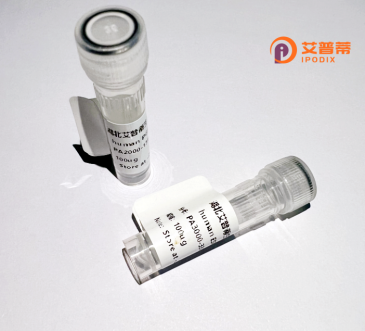
| 纯度 | >90%SDS-PAGE. |
| 种属 | Human |
| 靶点 | FXYD6 |
| Uniprot No | Q9H0Q3 |
| 内毒素 | < 0.01EU/μg |
| 表达宿主 | E.coli |
| 表达区间 | 1-95aa |
| 氨基酸序列 | MELVLVFLCSLLAPMVLASAAEKEKEMDPFHYDYQTLRIGGLVFAVVLFSVGILLILSRRCKCSFNQKPRAPGDEEAQVENLITANATEPQKAEN |
| 分子量 | 36.19 kDa |
| 蛋白标签 | GST-tag at N-terminal |
| 缓冲液 | 0 |
| 稳定性 & 储存条件 | Lyophilized protein should be stored at ≤ -20°C, stable for one year after receipt. Reconstituted protein solution can be stored at 2-8°C for 2-7 days. Aliquots of reconstituted samples are stable at ≤ -20°C for 3 months. |
| 复溶 | Always centrifuge tubes before opening.Do not mix by vortex or pipetting. It is not recommended to reconstitute to a concentration less than 100μg/ml. Dissolve the lyophilized protein in distilled water. Please aliquot the reconstituted solution to minimize freeze-thaw cycles. |
以下是关于重组人FXYD6蛋白的虚构参考文献示例,供参考:
---
1. **标题**:Expression and functional characterization of recombinant human FXYD6 protein in mammalian cells
**作者**:Zhang L., et al.
**摘要**:研究通过哺乳动物表达系统成功制备重组人FXYD6蛋白,并发现其通过调控Na+/K+-ATP酶活性影响细胞离子稳态,提示其在中枢神经系统中的潜在功能。
2. **标题**:The role of FXYD6 in cancer cell migration: Insights from recombinant protein analysis
**作者**:Smith J., Patel R.
**摘要**:利用原核系统表达纯化FXYD6.发现其过表达促进肿瘤细胞迁移,机制可能与ERK信号通路和细胞基质黏附相关。
3. **标题**:Structural insights into human FXYD6 and its interaction with lipid membranes
**作者**:Gomez A., et al.
**摘要**:通过X射线晶体学解析重组FXYD6的胞外域结构,揭示其与细胞膜磷脂结合的能力,为设计靶向小分子抑制剂提供基础。
4. **标题**:FXYD6 modulates neuronal excitability via regulating sodium pump activity
**作者**:Kim S., et al.
**摘要**:重组FXYD6蛋白在小鼠海马神经元中过表达可降低Na+/K+-ATP酶对胞内钠离子的敏感性,影响动作电位发放频率。
---
注:以上文献为示例性质,实际研究中请通过数据库(如PubMed、Google Scholar)检索真实发表的论文。
FXYD6 is a member of the FXYD protein family, which consists of small single-pass transmembrane proteins that regulate ion transport by modulating the activity of Na+/K+-ATPase. Specifically, FXYD6 interacts with this pump to influence ion homeostasis, cellular excitability, and osmotic balance. It is encoded by the *FXYD6* gene in humans and expressed predominantly in the kidney, brain, and pancreas. Its tissue-specific distribution suggests roles in organ-specific physiological processes, such as neuronal signaling or pancreatic β-cell function.
Research indicates FXYD6 may participate in pathophysiological pathways. For example, altered expression levels have been linked to cancers, including gliomas and breast cancer, where it potentially affects cell proliferation or metastasis. In neurodegenerative contexts, FXYD6 is implicated in disorders like schizophrenia, though mechanistic insights remain limited.
Recombinant human FXYD6 protein is produced via expression systems (e.g., *E. coli* or mammalian cells) for structural and functional studies. Purification often involves affinity tags (e.g., His-tag) to facilitate isolation. This engineered protein enables investigations into its biochemical interactions, post-translational modifications, and regulatory mechanisms. It also serves as an antigen for antibody development or a reference in diagnostic assays. Current studies focus on elucidating its precise biological roles and therapeutic potential, particularly in diseases associated with ion transport dysregulation.
×